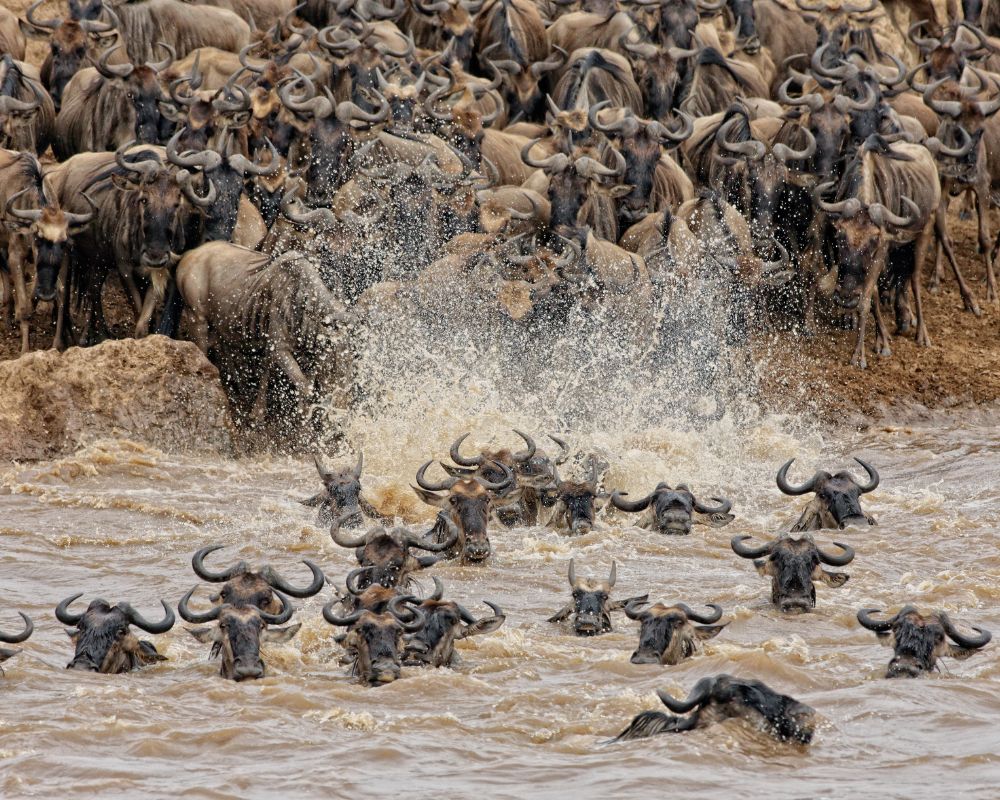The wildebeest migration is one of the most extraordinary natural spectacles on Earth, attracting wildlife enthusiasts and photographers from all corners of the globe. This annual event sees millions of wildebeest, accompanied by zebras and gazelles, traverse the Serengeti-Mara ecosystem in search of greener pastures. In this article, we delve into the fascinating facts and information about the wildebeest migration, providing insights into its significance, timing, and the best ways to experience it with Royal Star Expeditions.
What is the Wildebeest Migration?
The wildebeest migration is a massive, circular movement of approximately 1.5 million wildebeest, along with hundreds of thousands of zebras and gazelles, across the Serengeti in Tanzania and the Masai Mara in Kenya. This journey is driven by the animals’ instinctive search for food and water, as they follow the seasonal rains.
The Journey of the Wildebeest Migration
The wildebeest migration covers a vast distance of nearly 1,800 miles. The journey is fraught with peril, as the animals face numerous challenges, including predators, treacherous river crossings, and harsh weather conditions. Here is a brief overview of the key stages of the migration:
Calving Season
The migration begins in the southern Serengeti, where the wildebeest give birth to their young between January and March. This period, known as the calving season, sees around 500,000 calves born within a few weeks. The abundance of vulnerable young attracts predators, making it a dramatic time to witness the circle of life in action.
The Great Trek North
As the dry season sets in, the wildebeest herds start moving northward in search of fresh grazing lands. By May, they reach the central Serengeti, and by June, they arrive at the Grumeti River. This stage of the migration involves crossing crocodile-infested rivers, making it one of the most dangerous parts of their journey.
Crossing the Mara River
Between July and September, the herds reach the Mara River, the most iconic and perilous stage of the migration. The river crossings are a dramatic sight, with wildebeest braving strong currents and lurking crocodiles. Many animals perish in the process, but those that make it across reach the lush grasslands of the Masai Mara.
Return to the Serengeti
By October, the rains begin to return to the Serengeti, prompting the wildebeest to head back south. They pass through the eastern Serengeti, reaching their calving grounds by December. This completes the circular migration, and the cycle begins anew.
Why is the Wildebeest Migration Important?
The wildebeest migration is not only a breathtaking natural phenomenon but also a crucial ecological event. It plays a vital role in maintaining the balance of the Serengeti-Mara ecosystem. The grazing patterns of the wildebeest help regenerate the grasslands, while their sheer numbers provide sustenance for a wide range of predators and scavengers.
How to Experience the Wildebeest Migration
Witnessing the wildebeest migration is a once-in-a-lifetime experience that offers unparalleled opportunities for wildlife viewing and photography. Royal Star Expeditions specializes in organizing safari tours that allow you to get up close and personal with this incredible event. Here are some tips to make the most of your wildebeest migration safari:
Timing is Key
Understanding the timing of the migration is crucial to planning your safari. The migration follows a predictable pattern, but exact timings can vary based on rainfall. The best months to witness the river crossings are July to September, while the calving season offers a different yet equally captivating experience between January and March.
Choose the Right Location
Both the Serengeti and the Masai Mara offer excellent vantage points to witness the migration. Each location has its unique advantages, and Royal Star Expeditions can help tailor your itinerary based on your preferences and the migration’s current location.
Stay in Strategic Accommodations
Selecting the right accommodation can enhance your migration experience. Mobile camps that move with the herds provide a front-row seat to the action, while lodges in strategic locations offer comfort and proximity to key migration spots. Royal Star Expeditions partners with top-notch accommodations to ensure you have the best possible experience.
Conclusion
The wildebeest migration is a spectacular natural event that showcases the resilience and instincts of one of the world’s most iconic species. Understanding the facts and information about the wildebeest migration enriches the experience of witnessing this awe-inspiring journey. With Royal Star Expeditions, you can embark on a meticulously planned safari that brings you face-to-face with the wonders of the wildebeest migration, creating memories that will last a lifetime.
Whether you’re a seasoned wildlife enthusiast or a first-time safari-goer, the wildebeest migration offers a unique and unforgettable adventure. Plan your trip with Royal Star Expeditions and immerse yourself in one of nature’s greatest shows.

